| 1914 |
- Strand Electric begins as an office with workshop
in Garrick Yard, St Martins Lane in the heart of London's
theatreland.
|
| 1918 |
- The theatre electricians Arthur Earnshaw (Duke of York's)
and Phillip Sheridan (Strand Theatre) who founded the firm
are joined by Moss Mansell, a manufacturer of arc resistances
and dimmers in Cecil Court.
|
| 1922 |
- Round in Fifty at the London Hippodrome marks the
first use of the Sunray compartment batten. It becomes the
backbone of any Strand installation. The use of these with
filters instead of colour-dipped lamps was essential to Adrian
Samoiloff's scenic tricks using complementary colours.
|
| 1923 |
- The Theatre Lighting department is started by LG Applebee,
later to become Strand's first well known lecturer writer.
He ran it until retiring in 1957.
|
| 1924 |
- The Old Vic of Lilian Baylis: Strand's first "dead
front" switchboard was installed (still using DC electricity).
Until then, contacts and busbars had been mounted on the
front of polished slate panels.
- The Shepherd's Bush Pavilion (which later became the Gaumont
then the Odeon), the first of the great 3000 seat Super Cinemas
was provided with full stage lighting and concealed colour-change
lighting around the auditorium.
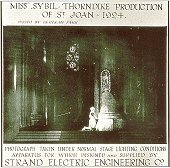
|
| 1924/5 |
- Wembley Empire Exhibition: complete installation with
cyclorama for Oliver Bernard's Battle of Zeebrugge
in the Admiralty Theatre. Except that its stage was a water
tank, this single tier, steeply-stepped house anticipated
by 35 years a form to become popular in the 1960's.
- Special lighting effects were also created in the new
stadium for productions of Fire of London and London
Defended. Special effects in other exhibition pavilions,
especially the optical projection of the British Guiana waterfall.
|
| 1925 |
- Royal College of Music, Parry Opera Theatre: Strand's
first (and last for 30 years!) patch panel.
|
| 1926 |
- C.B.Cochran's Revues at the London Pavilion, which included
One Darn Thing After Another and Coward's This
Year of Grace.
A famous and long-standing Picadilly Circus landmark produced
by Strand was the illuminated facade of the London Pavilion
proclaiming "The Centre of the World!"
Incidentally, the sign was never paid for as Strand Company
forgot to invoice it.
|
| 1927 |
- The first tennis superstar, Suzanne Lenglen, appears in
a C.B.Cochran revue, lit by Strand Lighting, at Holland Park
Skating Rink, London.
|
| 1928 |
- Stelmar ellipsoidal spot patent applied for; Strand now
set to make the first 1kW and 500W ellipsoidal profile spots
for the stage in the world.
|
| 1929 |
- Moss Mansell patents his Magnetic Clutch and makes possible
Strand's unique contributions to compact remote control of
lighting.
- Century Lighting opened in New York by Edward F. Kook
and his partners, Joseph Saul and Irving Levy, to serve Broadway.
- 3 June 1929: Work begins at the Savoy Theatre to install a new electrical and lighting system by Strand, following a production of Journey's End.
21 October 1929: The Savoy Theatre re-opens with a production of The Gondoliers. Strand's Arthur Earnshaw worked with designer Ionides to use concealed auditorium lighting to achieve 'glowing sunshine' (from Savoy Theatre history, 1992)
|
| 1930 |
- The new Adelphi opens with Ever Green and a new
installation by Strand. Lighting of this cyclorama show is
from floods and spots instead of the then staple, Sunray
compartment battens.
- Locarno Ballroom Streatham, a new dance hall wired and
equipped with architectural colour lighting by Strand.
|
| 1931 |
- Waltzes from Vienna - Strand's massed spots on
the circle front and on stage as used by Hassard Short are
a first at the Alhambra.
- Strand ventures into public building floodlighting. Nelson
on his column in London's Trafalgar Square is lit by two
Stelmars. Strand also lights the National Gallery and St.
Martin-in-the-Fields church.
|
| 1932 |
- The Shakespeare Memorial Theatre, Stratford-upon-Avon
- the only "modern" theatre built in Britain between
the Wars with the facilities FOH and backstage we have come
to expect today. Stage lighting included Stelmars out front,
cyclorama colour-mixing and a 56-way Grand Master board (Strand's
second, the first was in Halifax in 1931).
- June - The twenty year old Fred Bentham joins Strand Electric
in Covent Garden.
- Strand move the Works from Floral Street Covent Garden
to a new factory in Gunnersbury.
- In the USA, Century Lighting develops the Leko ellipsoidal
principle for Stanley Kingsley's "Dead End" on
Broadway, but it was to be several years before it found
its way into the catalogue.
|
| 1933 |
- Strand's first demonstration theatre (in Floral Street)
is opened by C.B. Cochran and used by Fred Bentham for Colour
Music recitals and as a Research and Development laboratory.
|
| 1934 |
- The new permanent installation for Sir Thomas Beecham
at the Royal Opera House was Strand's first job on a "Continental"
scale. The stage lighting load was 700kW AC and 150kW DC
controlled by Mansell clutch-driven dimmers from a unique
120-way remote control panel located on the perch.
|
| 1935 |
- Hassard Short's Stop Press, a revue whose lighting
effects heralded a "new era" although it was the
last to have to depend on the "old" range of traditional
Strand focus lamps for those effects.
- The Strand Light
Console is inaugurated with a recital of Colour Music
in the Floral Street theatre and has national press coverage.
It was the first lighting control in the world to use not
merely a moveable console but the organ principle of 'Select
& Play'; the common basis for today's memory control
systems.
- Century's latest catalogue announces "New Type Incandescent
Lekolites - A new application of an old light principle",
to replace "standard arc-carbon-fed lamps". This
advanced spotlight used an ellipsoidal reflector, base-up
1000-1500W lamp, and listed at $155.
|
| 1936 |
- Strand becomes a public company as Strand Electric Holdings
Limited.
- The BBC Alexandra Palace television studios open with
a Strand Grand Master dimmer board in each.
|
| 1937 |
First issue of "Tabs" magazine published. |
| 1939 |
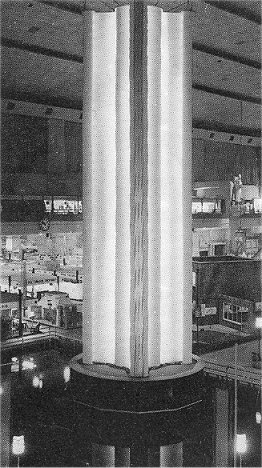
The Kaleidakon: 70 feet, 230kW tower in the Daily Mail Ideal
Home Exhibition, Earl's Court with a 72-way Light Console
and Compton Organ for Colour Music (photo above).
Strand's new King Street "temple" to the same art
opened that February (photo below).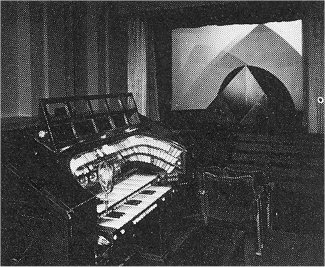 |
| 1940 |
- Teatro S'Carlos Lisbon: Strand's first Export of a complete
Continental opera house stage lighting installation. Control
by Light Console in orchestra pit.
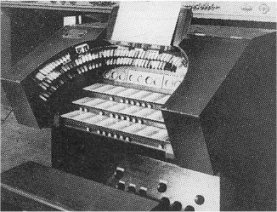
Cinema-organ style lighting control console, San Carlos,
Lisbon, 1940
|
| 1941 |
- Gangway: Robert Nisbett's revue for George Black
at the London Palladium. The lighting represented the peak
application of Strand's 1936 equipment to spectacle. The
Light Console (from the blitzed King Street) was out-front
at the end of the Grand Circle in the open.
|
| 1947 |
Working with George Izenour, Strand creates
the two-tube Thyratron dimmer, creating the first electronic
dimmers. |
| 1949 |
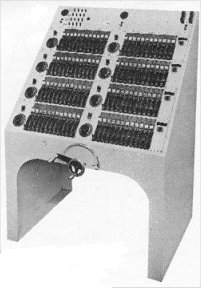 Reykjavik
Iceland: Strand's first Electronic Preset (120-way Thyratron
- pictured right) with complete installation for
the new National Theatre. Reykjavik
Iceland: Strand's first Electronic Preset (120-way Thyratron
- pictured right) with complete installation for
the new National Theatre.- Ankara Turkey: new National Opera House installation with
Light Console. Strand's Export Drive begins at last.
|
| 1951 |
- Festival of Britain: South Bank and Battersea Pleasure
Gardens, Strand Lighting and controls a-plenty and not just
in London, of course.
- Royal Festival Hall (the only permanent building to remain after the Festival of Britain) was equipped by Strand with a Light Console, and a complete lighting installation including long-range colour change spots. This led to the request for a 'duplicate' installation in Venezuela - at the Aula Magna in Caracas.
|
| 1952 |
- Strand's first branch office opens in Australia. (481 Malvern Road, South Yarra was the address, and Alec Brown, ex chief of the London Coliseum was the boss, with a small group of the crew from an Australian tour of 'Oklahoma!' which he had master-minded prior to the Strand opportunity.)
|
| 1953 |
- Pattern 23: first mass-produced theatre spotlight in the
World. First die-cast construction stage luminaire. Die-cast
by the 5000 for a market in which a gross (144) was thought
to be an outsize batch, it was destined to run for thirty
years. After the Lekolite, the 23 was the company's most
popular luminaire. Over 500,000 units were sold before 1983.
- Canada office opened by Strand Electric
|
| 1954 |
- The first remote controlled lighting system
is installed in studio 8H at NBC in the USA. Strand created
its first automated luminaires with motorized pan and tilt
for this project.
- Strand's King Street Demonstration Theatre re-opened, where it became the Mecca for stage lighting demonstrations and lectures until 1977.
|
| 1955 |
- Strand's German branch opens in Hessenbruch.
- The last Light Console was manufactured - for Theatre Polski in Warsaw.
|
| 1956 |
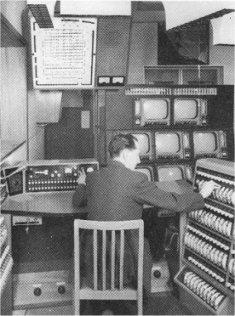 Start
of Commercial Television in the UK and of the BBC RIverside
pilot studios for the White City TV Centre project. Strand
controls, the majority of which are variants on the CD principle,
are supplied to TV Studios for the next decade. Strand have
to make patch panels! Start
of Commercial Television in the UK and of the BBC RIverside
pilot studios for the White City TV Centre project. Strand
controls, the majority of which are variants on the CD principle,
are supplied to TV Studios for the next decade. Strand have
to make patch panels!
Photo on the right shows Studio 3 Riverside Studioes,
1956
|
| 1958 |
The C Core dimmer system is installed at Yale
University. The C Core is the first SCR dimmer. |
| 1959 |
- Strand launch the Hook Clamp and free British theatre
from the tyranny of the traditional 2-bolt, 2 nut L Clamp.
- Strand Electric's office in Toronto, Canada opens.
- The Century Izenour 10 Scene preset is introduced.
|
| 1960 |
- Oliver! at the New (now the Albery) Theatre exposes
all Strand lanterns over the stage - an absence of masking
taken for granted nowadays.
- Television Centre, White City: first BBC Studios open
with Strand pole-operated Pattern 243 pressed-steel 2kW Fresnel
spots, System C controls and patching systems with "Jills"
instead of Jacks.
- Strand introduces the first moulded pin connector.
|
| 1962 |
- Chichester Festival Theatre: Britain's first new theatre
in thrust stage format and first LC control (72-way transistor/choke
preset).
- Blitz! at the Adelphi: first proscenium arch of
spots. A case of ancient and modern, for there was a massed
use of Strand's traditional optical flame effects but the
spots were the first cap-up ellipsoidals to be made over
here.
|
| 1963 |
- Junior 8: the new version of the existing Junior Switchboard is an 8-way 4-slider portable for amateurs
and others on a budget, is introduced at £45 list
(and many are still in use 20 years later).
|
| 1964 |
- Strand celebrates its Golden Jubilee.
- The C Card plug-in preset controller system is introduced.
- The Edkotron dimmer system becomes the first modular,
portable electronic dimming system; Strand's Thyristor dimming
systems installed at the Royal Opera House in London and
at the Glyndebourne Festival Opera House.
|
| 1966 |
- Strands first instant dimmer memory control (IDM/R) is
demonstrated in March and two large installations are ordered
for Ottawa.
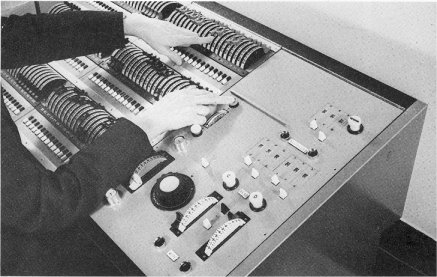
The first instant dimmer control, 1966
|
| 1968 |
- Strand Electric is purchased by the Rank Organisation
to become Rank Strand Electric.
- The Memo Q console is developed with George Van Buren
as the first computerised memory system.
|
| 1969 |
- In the USA, Rank takes over Century Lighting which becomes
Strand Century. National Arts Centre Ottawa opens with 5
Strand patch-panels and two IDM/Rs.
|
| 1972 |
- The Royal Shakespeare Theatre, Stratford-upon-Avon: the
new 240-way DDM computer system is used for the season of
the Roman plays.
|
| 1973 |
- The launch of the World's first Modular Memory System
(M.M.S.) using the now famous - and widely copied - control
wheel.
- Tungsten Halogen lamp revolution arrives, around which
Strand launch their 700 series lanterns.
- The 100th issue of TABS (Strand magazine).
|
| 1975 |
- La Scala, Milan: DDM 320 channel Memory Lighting Control.
First Strand system in a major Italian Opera House.
The largest MMS ever made, 480 channels, is installed
in the Congress-Hall complex in Pyongyang, Korea. See Photos from Bob Hartley showing the installation.
|
| 1976 |
- Lightboard: second generation computer controlled memory
system engineered specially for the National Theatre, from
a concept by Richard Pilbrow. The massively popular Galaxy
desk is a direct descendant.
- Compact: the first truly transportable memory system is
accepted by the BBC for Outside Broadcast and is installed
in the Duke of York's Theatre, London and Alcala Palace,
Madrid.
- Multi Q becomes the first commercial memory system on
Broadway when used by Tharon Musser on A Chorus Line.
Correction: The Electronics Diversified LS-8 in 1975 was the first commercial memory system used by Tharon Musser on A Chorus Line. The Multi-Q was used on the first A Chorus Line TOUR in 1976 to avoid the Skirpan patent lawsuit against EDI for alleged infringement of the AutoCue patent (thanks to Steve Terry for this correction).
|
| 1977 |
- Lightboard for the Royal Opera House, Covent Garden.
- AMC - Advanced Manual Control - introducing true dipless
crossfades to manual systems, takes over from Threeset.
- The Micro Q memory plus Manual console is introduced.
- Strand Modular Memory System and STM dimmers installed
at Glyndebourne.
|
| 1978 |
- T/84 Variable Beam Profile Spot, the ultimate development
of the T-Spot, makes its first appearance and sells over
600 units in its first week on offer.
- The Lightpalette lighting console is introduced and the
Tracking style of memory control with multi-part fades is
created.
|
| 1980 |
- Tempus takes over from Mini-2. Over 300 sold in 5 years.
- Galaxy launched and chosen for the BBC Television Centre
and The Barbican - London-based home of the Royal Shakespeare
Company.
- CD80 dimmer introduced and becomes the first and arguably
the most successful high density dimmer system. Dimmer-per-circuit
operation becomes commercially viable for the first time.
|
| 1981 |
- Prelude, Harmony and Minim, Strand's new series of Profile,
Prism Convex and Fresnel spots shown for the first time at
ABTT Trade Show.
- Strand enter the commerical Dimming market and launches
the Environ range.
|
| 1982 |
- The Barbican Centre, pride and joy of the City of London
opens its doors for the public. A shop window for the Strand
Group, suppliers of production lighting and control systems,
sound and communication installations and controls, auditorium
seating, stage engineering and electrical contracting.
- Mantrix manual control console introduced with multiplex
control wiring and electronic patch.
- Environ 2, the first micro-processor based architectural
lighting control system is introduced.
|
| 1983 |
- Undoubtedly the year of the M24 - the micro-processor
control which opened the door of sophisticated memory lighting
facilities to the small scale theatres and TV Studios. Production
began in July and M24 was chosen to light a video recording
of Giselle at the Kirov Theatre, Leningrad, later
in the month.
- TV-AM: Both studios fully equipped by Strand Group with
Quarzcolor luminaires, Strand Galaxy lighting controls and
dimmers, Tele-Stage studio suspension and electrical contracting
by Strand.
- Limehouse, an independent studio facility in the heart
of London's Dockland also fully equipped by Strand Group
with Quartzcolor luminaires, Galaxy lighting controls, Tele-Stage
suspension equipment and electrical contracting by Strand.
- 1983 saw the end of the Pattern 23 the first die-cast
lantern, 30 years in production and half a million made and
sold. All good things must come to an end.
- Strand complete their new range of luminaires with the
introduction of Cadenza 2000W spots, Minim small 500W spots,
Nocturne and Coda flood and cyclights.
|
| 1984 |
- M24 features in the ABTT Awards at this year's Trade show
and wins a coveted "silver" plated hook clamp,
for starting a trend, perhaps exemplified by its operating
philosophy, which it is suggested others will follow.
- Galaxy 2 introduced - no longer a single multipurpose
lighting control, but a range of systems incorporating specialised
developments in control and programming for TV studios, theatres
and major opera houses.
- Galaxy 2 Arena incorporates all the features of its predecessor,
but is now supplied in rich dark walnut veneer as standard
|
| 1985 |
- M24 is expanded to 120 channels and has substantial improvements
in memory capacity.
- Solo followspots developed from Cadenza lens system.
- Act 6 dimmer pack introduced.
- New facilities added to Galaxy
|
| 1986 |
- Premiere architectural lighting control system is introduced.
The system offers a wide range of fully programmable functions
on every station. Multiplex control LAN wiring simplifies
installation.
- Strand buys Quartzcolor.
|
| 1987 |
- Strand Galaxy installed at Glyndebourne Festival opera
house.
|
| 1988 |
- 4th January: The London offices move from Brentford to Grant Way, Isleworth
|
| 1990 |
- The Lightpalette 90 control console dramatically expands
the functionality and performance of the Lightpalette operating
system. The installed base of over 700 systems exceeds the
quantity of all other Lightpalettes previously sold.
|
| 1991 |
- Strand Lighting becomes the first company (and only North
American company) to achieve ISO9000 Quality certification.
Applied to all of our current line of electronic products
this rigorous quality programme assures customers that they
will receive the most reliable equipment possible.
|
| 1992 |
- Strand Lighting registered to BS5750: Part 1: 1987, EN29001-1987
and ISO9001-1987.
- The first fully digital status reporting dimming system,
the CD90, is installed at the Canadian Broadcasting Corporation.
This high end system brought full 2000-step fade resolution
with line and load compensation to high density dimmer racks
for the first time. CD90 wins the Lighting Dimensions New
Lighting Product of the Year
- Strand Galaxy Nova with C1 software introduced.
|
| 1993 |
- GSX lighting control console is introduced. GSX is the
first software-based lighting control system that allows
the user to choose from a wide range of software packages.
|
| 1994 |
- The Premiere Network Manager wins the Lighting Dimensions
International product of the year for Architectural lighting.
This user-friendly Windows-based program is designed for
use as the Central Lighting control for major hotel, convention
and presentation facilities.
- Strand introduces Genius Plus and Tracker software for
its 430 and 530 series consoles. These systems integrate
for the first time montion control and theatrical-style cue
writing on a single console. This series of consoles is the
first to operate 32-bit pre-emptive multi-tasking software.
|
| 1994 |
- The latest generation of the CD80 dimmer is introduced.
CD80SV combines the rugged construction of CD80 with the
technological enhancements of CD90 to produce an economical
high-performance digital dimming system.
|
| 1995 |
- Enhanced Lightpalette software is introduced for the 430/530
and new 550 series consoles. Combining the power of these
hardware platforms with Lightpalette and Tracker software,
Strand has created a new standard in lighting control.
|
| 1997 |
- Strand updates lighting system at San Francisco Opera
House with two 550i consoles and almost 2000 CD80 dimmers.
This is the first major Shownet Ethernet distribution system.
|
| 1998 |
- ParkNet control system is developed for Universal Studios
Islands of Adventure theme park. The ParkNet control system
is able to operate an entire theme park's lighting system
from a central location, using Ethernet data distribution.
The system can route DMX data for up to 18,000 devices on
the network.
|
| 1999 |
- 8 new compact, highly efficient cool-beam SL luminaires
introduced in March at USITT in Toronto, including 6 fixed-angle
versions and two zoom fixtures.
- 300-series lighting control consoles introduced to cover
entry level to mid-range users (seven consoles, and a new
compact show controller). Modular in construction, they can
be arranged in any pattern to suit the needs of a wide range
of users. Panels may be remote up to 300 feet from the main
processor for flexible functionality.
|